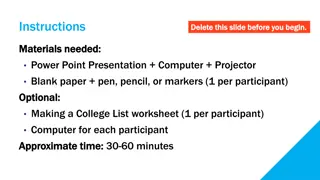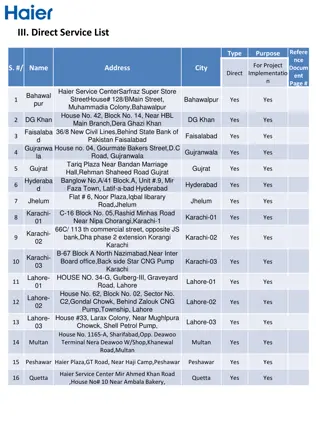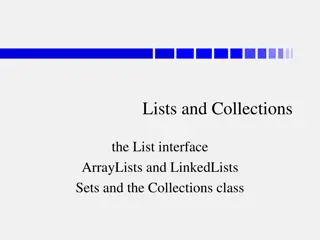
Introduction to Linked Lists and Dynamic Memory Allocation
Explore how linked lists offer a dynamic solution for organizing data, compared to arrays. Learn about programmer-initiated memory allocation in C using functions like malloc and calloc, enabling efficient management of memory. Discover the benefits of using linked lists for improved performance in data manipulation operations.
Uploaded on | 0 Views
Download Presentation

Please find below an Image/Link to download the presentation.
The content on the website is provided AS IS for your information and personal use only. It may not be sold, licensed, or shared on other websites without obtaining consent from the author. If you encounter any issues during the download, it is possible that the publisher has removed the file from their server.
You are allowed to download the files provided on this website for personal or commercial use, subject to the condition that they are used lawfully. All files are the property of their respective owners.
The content on the website is provided AS IS for your information and personal use only. It may not be sold, licensed, or shared on other websites without obtaining consent from the author.
E N D
Presentation Transcript
Linked-Lists Dynamic Memory Allocation
Introduction to Linked Lists Arrays organize and process data items sequentially. You probably have learned operations on arrays such as sorting, inserting, deleting, and searching. If data items are not sorted, then searching for an item in the array can be very time-consuming, especially with large arrays.
Introduction to Linked Lists Once the data items are sorted, we can use a binary search and improve the search algorithm; however, insertion and deletion become time- consuming, especially with large arrays, because these operations require data movement. With an array of fixed size, new items can be added only if there is room. Thus, there are limitations when organizing data in an array.
Introduction to Linked Lists One way to improve performance when there is a need to insert and/or delete items is to use a data structure that is not contiguous in memory, such as a linked list.
Linked Lists a data structure in which each element is dynamically allocated and in which elements point to each other to define a linear relationship. elements are allocated separately and only when needed elements are usually the same type (but not always)
Dynamic memory allocation Programmer-initiated allocation from the heap In C, three functions (from stdlib.h) malloc calloc realloc
malloc() void * malloc(size_t size); returns a void pointer to allocated memory (which can be assigned without a cast but you should cast the return type), or NULL allocated block is (size) number of bytes; size is the size of each item multiplied by the number of items contents of allocated block are NOT initialized (size_t is an unsigned integer)
calloc() void * calloc(size_t single_item, size_t number_of_items); returns a void pointer to allocated memory (which can be assigned without a cast but you should cast the return type), or NULL allocated block is (sizeof(single_item) * number_of_items) bytes contents of allocated block are initialized to 0
malloc() and calloc() you should always check to see if returned value is NULL or not int * p; p = (int *)malloc(sizeof(int)); if(p == NULL) { printf( out of memory\n ); exit(1); }
realloc() void * realloc(void *ptr, size_t size); changes the size of a previously allocated block returned pointer may differ from passed pointer NULL if not successful or a pointer to a different part of the heap where the requested larger block was available (the previously allocated block is deallocated) contents of allocated block are NOT initialized
deallocation also in stdlib.h void free (void *ptr); should only use a pointer value (i.e. memory address) that was previously provided by a call to one of the allocation functions
Allocating arrays #define LENGTH 100 int *pa = (int *) malloc(LENGTH * sizeof(int)); if (pa == NULL) { printf( out of memory\n ); exit(1); } for (int i = 0; i < LENGTH; i++) pa[i] = 0; // can use array notation
Allocating a structure typedef struct node_s { int data; struct node_s * next; } node_t; node_t * pn; pn = (node_t *)malloc(sizeof(node_t)); if (pn == NULL) { printf( out of memory\n ); exit(1); }
Pointer problems dangling pointers when an allocated block is freed but the pointer is not set to NULL and then later, the pointer is unknowingly dereferenced - this can lead to a crash or hard-to-find error when two pointers point to the same object and one of them is used to free the object and then set to NULL but the other keeps the address C does not check for dangling pointers
Pointer problems storage leak when you reassign the only pointer to an object, access to the original object is lost and that object can no longer be used or freed (it becomes garbage ) when a function returns without freeing an allocated object Unlike Java, C provides no mechanism for garbage collection. valgrind can help find memory leaks
Linked Lists each element of the structure is typically called a node Example of a singly-linked list with a head pointer. Nodes are added to the front of the list. - indicates that the pointer is NULL
Introduction to Linked Lists Example of a singly-linked list with a head and tail pointer. Nodes can be added to the front or the end of the list.
Comparing Arrays and Linked Lists Both arrays and linked lists can be used to store linear data of similar types, but they both have some advantages and disadvantages over each other. Advantages of Arrays: We can randomly access an element of an array by using its index. When sorted, we can use a binary search to improve the searching algorithm
Comparing Arrays and Linked Lists Disadvantage of Arrays: The size of an array is fixed: So we must know the upper limit on the number of elements in advance. Generally, the allocated memory is equal to the upper limit irrespective of the usage In practical uses, upper limit is rarely reached; therefore wasted memory. With an array of fixed size, new items can be added only if there is room.
Comparing Arrays and Linked Lists Disadvantage of Arrays: Inserting new elements is time-consuming, because room has to be created for the new elements and, to create room, existing elements have to be shifted. Deleting elements is time-consuming, if deleting elements not at the end of the array. e.g., to delete the ith element, everything after the ith element must be shifted up.
Comparing Arrays and Linked Lists Advantages of Linked Lists: We can increase the size of the linked list one item at a time, dynamically. We can easily insert elements in a linked list. We can easily delete elements from a linked list.
Comparing Arrays and Linked Lists Disadvantages of Linked Lists: Random access is not allowed. We have to access elements sequentially, starting from the first node. So we cannot do binary search with linked lists. Require extra memory space for a pointer in each node of the list.
Introduction to Linked Lists Types of Linked Lists A singly linked list as previously described A doubly linked list - a list that has two references, one to the next node and another to the previous node. 2 7 3 1
Singly Linked List typedef struct listItemType { type payload; struct listItemType *next; }listItem; listItem *head; payload next payload next payload next payload next
Adding an Item to a List listItem *p, *q; Add an item pointed to by qafter item pointed to by p Neither p nor q is NULL payload next payload next payload next payload next payload next
Adding an Item to a List listItem *addAfter(listItem *p, listItem *q){ q -> next = p -> next; p -> next = q; return p; } payload next payload next payload next payload next payload next
Adding an Item to a List listItem *addAfter(listItem *p, listItem *q){ q -> next = p -> next; p -> next = q; return p; } payload next payload next payload next payload next payload next
Adding an Item to a List Question: What should we do if we cannot guarantee that p and q are non-NULL? listItem *addAfter(listItem *p, listItem *q){ q -> next = p -> next; p -> next = q; return p; } payload next payload next payload next payload next payload next
Adding an Item to a List (continued) listItem *addAfter(listItem *p, listItem *q){ if (p && q) { q -> next = p -> next; p -> next = q; } return p; } payload next payload next payload next payload next payload next
What about Adding an Item before another Item? struct listItem *p; Add an item before item pointed to by p (p != NULL) payload next payload next payload next payload next payload next
What about Adding an Item before another Item? Answer: Need to search list from beginning to find previous item Add new item after previous item






















